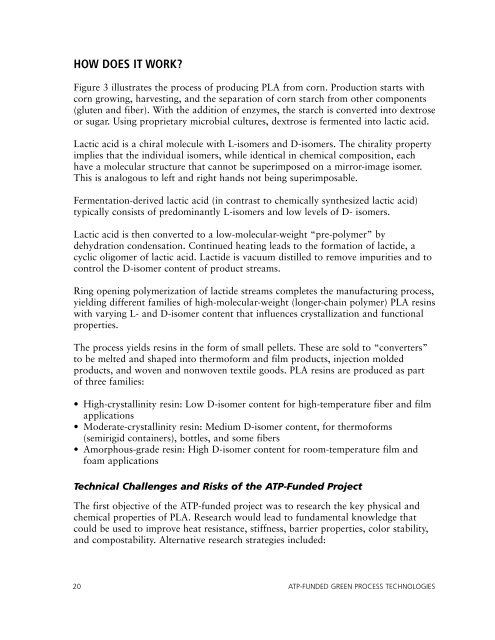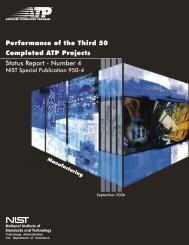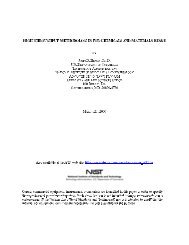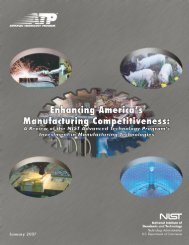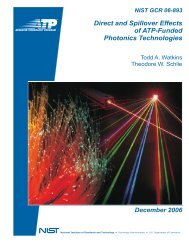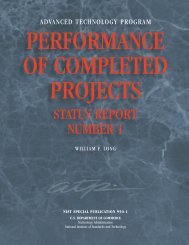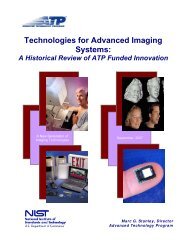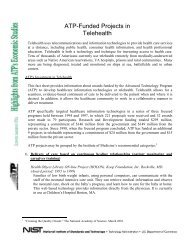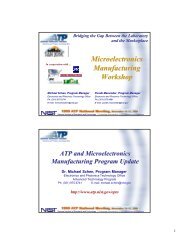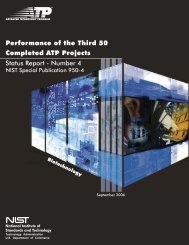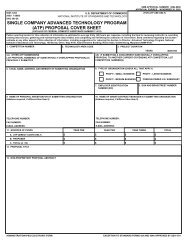ATP-Funded Green Process Technologies - NIST Advanced ...
ATP-Funded Green Process Technologies - NIST Advanced ...
ATP-Funded Green Process Technologies - NIST Advanced ...
Create successful ePaper yourself
Turn your PDF publications into a flip-book with our unique Google optimized e-Paper software.
HOW DOES IT WORK?<br />
Figure 3 illustrates the process of producing PLA from corn. Production starts with<br />
corn growing, harvesting, and the separation of corn starch from other components<br />
(gluten and fiber). With the addition of enzymes, the starch is converted into dextrose<br />
or sugar. Using proprietary microbial cultures, dextrose is fermented into lactic acid.<br />
Lactic acid is a chiral molecule with L-isomers and D-isomers. The chirality property<br />
implies that the individual isomers, while identical in chemical composition, each<br />
have a molecular structure that cannot be superimposed on a mirror-image isomer.<br />
This is analogous to left and right hands not being superimposable.<br />
Fermentation-derived lactic acid (in contrast to chemically synthesized lactic acid)<br />
typically consists of predominantly L-isomers and low levels of D- isomers.<br />
Lactic acid is then converted to a low-molecular-weight “pre-polymer” by<br />
dehydration condensation. Continued heating leads to the formation of lactide, a<br />
cyclic oligomer of lactic acid. Lactide is vacuum distilled to remove impurities and to<br />
control the D-isomer content of product streams.<br />
Ring opening polymerization of lactide streams completes the manufacturing process,<br />
yielding different families of high-molecular-weight (longer-chain polymer) PLA resins<br />
with varying L- and D-isomer content that influences crystallization and functional<br />
properties.<br />
The process yields resins in the form of small pellets. These are sold to “converters”<br />
to be melted and shaped into thermoform and film products, injection molded<br />
products, and woven and nonwoven textile goods. PLA resins are produced as part<br />
of three families:<br />
• High-crystallinity resin: Low D-isomer content for high-temperature fiber and film<br />
applications<br />
• Moderate-crystallinity resin: Medium D-isomer content, for thermoforms<br />
(semirigid containers), bottles, and some fibers<br />
• Amorphous-grade resin: High D-isomer content for room-temperature film and<br />
foam applications<br />
Technical Challenges and Risks of the <strong>ATP</strong>-<strong>Funded</strong> Project<br />
The first objective of the <strong>ATP</strong>-funded project was to research the key physical and<br />
chemical properties of PLA. Research would lead to fundamental knowledge that<br />
could be used to improve heat resistance, stiffness, barrier properties, color stability,<br />
and compostability. Alternative research strategies included:<br />
20 <strong>ATP</strong>-FUNDED GREEN PROCESS TECHNOLOGIES


